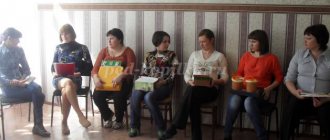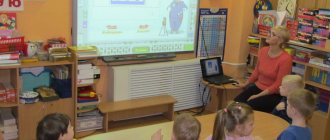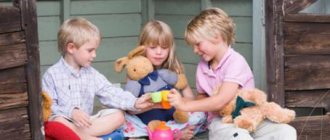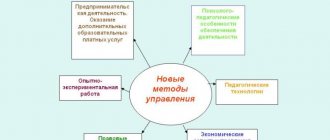23174_do_thematicheskie_dni.docx
Federal State Educational Standard for Educational Education "Thematic days in the educational process." Many articles based on work experience have been written about how interesting it is to organize the lives of children in kindergarten. Teachers develop scenarios for classes, holidays and entertainment, materials for project activities and much more. All this is just as important as designing a holistic model for organizing the educational process for the entire academic year, including these individual events. In other words, create a system, consistency in planning the educational process. Pedagogical tasks in all educational areas of the FG' OS DO are implemented in the educational process of the kindergarten. Each institution independently designs a model for organizing education and upbringing for preschoolers and draws up its own basic educational program. The principle of comprehensive thematic planning, taking into account the integration of educational areas, involves the inclusion of thematic weeks, thematic days, and thematic walks. Let's try to understand these concepts. All proprietary variable educational programs for each age group present topics for the entire school year, which are usually used by educators. The selection of topics adds consistency to the educational process and is aimed at expanding the child’s awareness of the world around him. A creative approach to modeling the educational process assumes that the teacher independently (at his own discretion) can partially or completely replace the topic, adjust the content of the work, and include a regional and cultural component, taking into account the characteristics of his preschool educational institution. If you look into history, the thematic principle of organizing the educational process in working with preschoolers was proposed by many specialists. The Belgian educational psychologist, doctor J. O. Decroly (1871-1932) wrote in his work “The School of Life for Life”: “I have the goal of creating a connection between the sciences and making them converge in one center. This center is a child, to which everything converges and from which everything diverges.” He created the “School of Life through Life” for children, where “interest centers” were developed for preschoolers, the essence of which was to organize children’s work around topics that meet children’s interests and needs. In these centers, children observed, read, wrote, drew, and sculpted things that were related to the topic given to them. In modern practice, speech therapists actively use the thematic principle of planning and organizing work with preschoolers, selecting a variety of material on topics. E. Alyabyeva’s book “Thematic days and weeks in kindergarten” by the publishing house “TC Sfera” has long been in high demand among educators. Answering the question “What is a themed day in kindergarten? “, we can say that this is an unusual day for children. It is filled with surprises, games, riddles, and exciting journeys. On this day, children learn a lot of new, useful and interesting things; they are sure to make something, draw, and fantasize. On this day, something changes in the group room: new toys appear, favorite characters from cartoons and fairy tales come to visit, and sometimes a puppet theater comes. For the teacher, the theme day is pedagogical creativity, ingenuity and transformation. This is serious planning of all routine moments, a departure from the traditional outline plan to drawing up a scenario for the day as a whole or its components - routine moments. To make this day memorable for children, the teacher comes up with surprise moments, elements of including children in games and exciting activities. In an ordinary, traditional day, the basis is the routine, and the content is, as it were, strung together with routine moments. Often, the content of a morning reception, gymnastics, or a walk may not be at all combined with the content of the educational activity itself and exist on their own. The difference between a thematic day and a traditional one is that at the center of the pedagogical process is a theme chosen by the teacher for educational purposes and combined with a holiday or calendar event. The theme of the day sets the content, which is implemented in various types of children's activities (play, communication, cognitive-research, perception of fiction and folklore, self-service and basic household work, construction, visual, musical and motor). A game (role-playing, directorial, dramatization, with rules, etc.) is also one of the forms of content implementation. Considering the game as a free independent activity for children, the teacher thinks through how most of the content of the thematic day can be implemented. Thus, in older groups, games appear that involve traveling, for example, in time. And then the interested participation of children according to the principle “let’s come up with something else. . . » saturates the educational process with the interests of children, and not just adults. They become not performers, but active participants in the simulation of such a game. When organizing a theme day, the content of the educational areas is naturally integrated. This allows the teacher to integrate educational activities and avoid unjustified fragmentation of children’s activities into educational areas. During such days, the teacher shows his creativity, takes into account the characteristics, level of knowledge and skills of the children in his group. A theme day is about immersing children in a topic, which gives them the opportunity to realize and feel what the teacher wants to convey to them. The theme of the day can be the same for all age groups or chosen only for a specific age. For example, on the first day of summer (June 1) World Milk Day is celebrated (at the proposal of the UN Food and Agriculture Organization since 2001). The purpose of the holiday is to popularize milk and dairy products, inform the population about activities related to dairy production. On this day, the preschool educational institution can organize fun dairy-themed performances with fairy-tale characters, games and sports competitions. Stories about the benefits of milk, about dishes that can be prepared using it, and treating children to milk will make this themed day not only fun, but also tasty. A thematic day can be organized for all groups at the same time, but each teacher selects his own content and forms of organizations, focusing on common events (entertainment, performance, competition, etc.). A single theme in different age groups ensures the achievement of unity of educational goals and continuity in development from age to age. When drawing up a scenario for a thematic day, it is important for the educator to comply with several important conditions: to be able to objectively assess the level of his work, the real situation and conditions in which educational activities are carried out at the time of planning (what the children and I have already gone through, what results have been obtained); be able to identify goals and objectives, correlating them with the educational program, age composition of a group of children, priority areas of the entire educational process in preschool educational institutions; clearly represent the results of the work that must be achieved (what new children will learn, what they will learn, what personality qualities they will develop); choose the optimal forms, means, methods that help achieve your goals, and therefore obtain the planned result. The plan-scenario of the thematic day should ensure the unity of the educational, developmental and training goals and objectives of the education of preschool children and the integration of educational areas. I would like to remind you that the principle of integration of educational areas underlies all the work of the educator, and, in our opinion, it is not at all necessary, after planned work, to constantly indicate in brackets which educational areas this or that activity belongs to. With the introduction of the Federal State Educational Standard for Preschool Education and following the logic, it can be argued that if the educational process in kindergarten unfolds in a complex thematic model and educational tasks are implemented not only in the classroom, but also in routine moments according to the developed daily scenario in each group and throughout kindergarten. In our kindergarten, theme days are included in the educational program. And this was done quite creatively, without driving the teacher into yet another “trap” - obligatory! A collection of interesting scenarios for themed days is created through the creative efforts of its entire teaching staff. Each scenario is actively discussed both before and after the theme day, and only the successful ones are kept in the kindergarten teaching room. This work experience may be useful to other educators in the future. This makes the model of our educational process diverse and is reflected in the educational program of the kindergarten. In complex thematic planning, the requirements for the conditions for the implementation of the preschool education program are observed, one of which is “the use in educational activities of forms and methods of working with children that correspond to their age and individual characteristics (the inadmissibility of both artificial acceleration and artificial slowdown of development children’s age)” (Federal State Educational Standard of Education). Our teaching staff independently decides how often themed weeks, themed days, and themed walks will be planned. We are confident that there cannot be strict regulation here. The principle of comprehensive thematic planning and inclusion of the educational process in the organizational model is being developed and widely discussed at teacher councils.
Outline of a theme day in kindergarten
Svetlana Leontyeva
Outline of a theme day in kindergarten
Outline of a theme day in kindergarten
"Space Travel Day - Cosmonautics Day"
.
Educator: Leontyeva Svetlana Vladimirovna
Outline of the theme day in kindergarten “Space Travel Day - Cosmonautics Day”
.
Scenario for organizing a themed day in kindergarten “Space Travel Day”
"Cosmonautics Day"
Purpose: To give children an idea of the “Cosmonautics Day”
and elementary ideas about space.
Objectives: To introduce children to the holiday “Cosmonautics Day”
And
with space pioneers;
Develop memory, speech, observation, logical thinking, interest in learning about the world around us;
Learn to apply acquired knowledge in different types of activities;
Encourage verbal communication among themselves, contact adults with questions, judgments and statements.
Morning: When meeting children in a group, the teacher reminds the children that today is an unusual day. Today we will go on an unusual journey, and in order to understand where, we invite children to look at illustrations and postcards depicting space, reproductions of A. Leonov’s paintings “The Universe”
, B. Baksheeva
“Blue Spring”
. She also offers didactic games for children:
“Find the extra
,
“Find the way to Earth according to
the plan . ”
The teacher asks the children, have you guessed what our journey will be dedicated to? Of course, our journey is connected with space, because today is “Cosmonautics Day”
.But in order for our trip to be memorable, you and I will arrange an exhibition for parents from your works:
“Space”
.
If you are ready to travel, then let's go. The teacher asks the children to close their eyes, turns on the Cosmic Symphony, gradually the music fades out, and the children open their eyes. The teacher tells them that they have arrived at the first stop “Adroit Cosmonauts”
.
Morning exercises
At the bus stop, the teacher conducts morning exercises. Using outdoor switchgear and the outdoor game “Planes are landing!”
.
The teacher says that in order to continue our journey we need to learn about space, he offers to tell the history of astronautics.
Morning conversation: “History of astronautics”
Goal: To promote the acquisition of knowledge about changes in wildlife in the spring (the arrival of birds, the appearance of primroses and insects)
; about relationships in natural phenomena; stimulate the development of attention, memory and speech. Well, now let's continue our journey. The teacher asks the children to close their eyes, turns on the Cosmic Symphony, gradually the music fades out, and the children open their eyes.
Our second stop is called "Cosmonaut's Breakfast"
. Therefore, like the best astronauts, we wash our hands and take our space spoons to eat.
Morning hygiene procedures. Breakfast.
Well done, let's continue our journey.
Next stop “Cosmic knowledge”
.
Cooperation 1. Development of speech “This mysterious space!”
Goal: Summarize and systematize children's knowledge ; expand ideas about the astronaut profession; develop speech and imagination.
Making riddles: “Moon riddles”
(about space, astronauts)
.
(Goal: development of logical thinking, memory, replenishment of children’s active vocabulary).
Physical exercise: “Don’t be late for the rocket”
.
Collaboration 2. Application “Rocket”
Goal: To consolidate the ability to symmetrically cut paper folded in half into four. Introduce children to the structure of a rocket and its purpose.
Finger gymnastics: “Cosmonaut”
.
— The sun is shining in the clear sky, The astronaut is flying in a rocket. And below the forests, fields, the earth spreads out.
Well done, we learned a lot at this stop, and now our journey goes beyond the group, we will continue our journey outside.
Walk.
(Purpose of the walk: health-improving organization of active recreation for children in the fresh air).
Outdoor game: “Flies or doesn’t fly”
(Goal: to develop running skills, the ability to quickly respond to the driver’s signal, memory development, knowledge of the words of the game).
Observation. Based on the theme of the season .
Labor: on the kindergarten , depending on the time of year.
Outdoor game: “Cosmonaut School”
Goal: improve interval jumping, develop agility and attention.
My cosmonauts, we have returned to our route, returned to the group, the journey continues. The teacher asks the children to close their eyes, turns on the Cosmic Symphony, gradually the music fades out, and the children open their eyes.
This stop is “First Cosmonaut”
Returning from a walk. The teacher, while the attendants and the junior teacher are setting the table, suggests a conversation on the topic “The first man in space”
,
“Our Cosmonauts” (using illustrations by A. Leonov)
.
(Target
: introducing children to the first cosmonauts using pictures).
Guys, we learned a lot today about space, so it’s time for us to return to our group, where we can apply all the knowledge gained in our group, independently. And of course, all together we will organize an exhibition for parents.
Hygiene procedures and lunch. Then the children gradually prepare for bed: they visit the toilet room, undress and go to the bedroom.
There is a gradual rise of the children, to the music of increasing character, and the children perform elements of corrective and breathing exercises in their beds. The children are having lunch.
Role-playing game: “Space Journey”
(Goal: to create conditions for enriching children with impressions that can be used in the game; to encourage the development of the plot of this game)
Afternoon snack. Independent activity of children.
Didactic game: “Assemble the rocket in parts”
.
Goal: to consolidate children's knowledge about the structure of a rocket and its purpose).
Drawing on the theme: “Space travel”
(Goal: learn to display your impressions in a drawing using unconventional drawing methods).
Listening to audio recording: “Space Symphony”
(Goal: development of auditory perception, education, emotional responsiveness, development of interest in classical music).
“Cosmos” in the locker room
(at the exhibition there are works on appliqué, drawings on this
topic ).
The teacher must create a subject-development environment, plan and organize children throughout the day, and be able to organize a walk on the topic. Know the level of development of children in this area, determine the forms and methods of interaction with the family.







